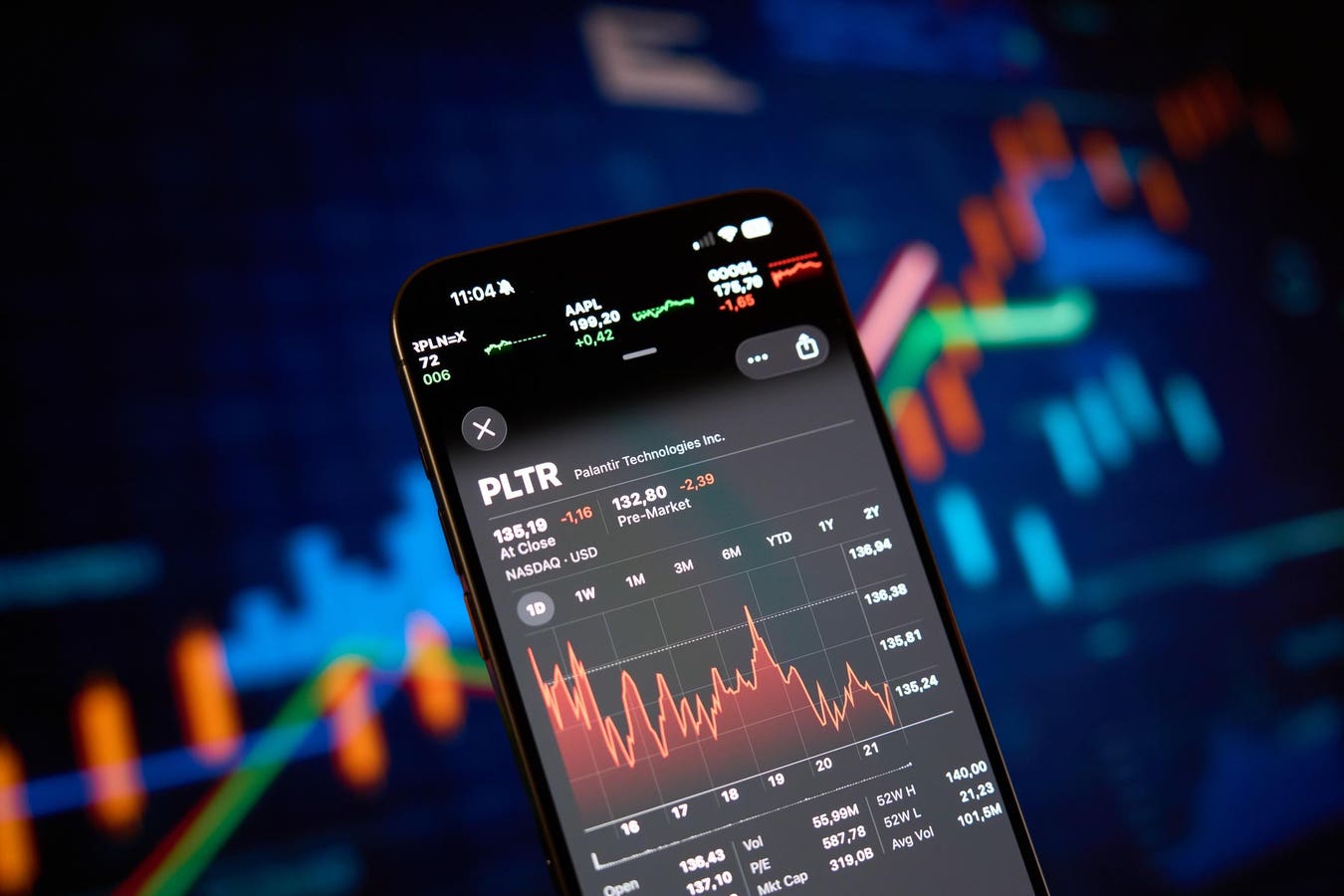The Palantir stock price is seen with a stock price graph in the background in this illustration photo taken in Warsaw, Poland on 13 June, 2025. (Photo by Jaap Arriens/NurPhoto via Getty Images)
NurPhoto via Getty Images
In recent weeks, AI investors and enterprise leaders have felt the yo-yo effect of the AI market. Starting August 18, a four-day slide erased almost $1 trillion from the market caps of tech’s megacap companies. Nvidia, Palantir, and other so-called AI companies shed billions in value in a matter of days. Meta has announced a hiring freeze in its AI division. Even the CEO of OpenAI, Sam Altman, casually remarked that “AI is a bubble.”
The irony? Engineers in the sector continue to command $100 million pay packages. AI startups continue to raise funding at valuations that defy gravity. Additionally, companies from Microsoft to Google are integrating AI features across their products at a record speed. The real question isn’t whether AI is a bubble. The better question is: what kind of bubble—if any—are we in, and what comes after?
The Market Signal: Projections Meet Reality
For much of the past 18 months, AI stocks soared based on projections and expectations. Nvidia tripled in value. Palantir’s valuations are reminiscent of the dot-com era. In August, the S&P’s price-to-book ratio reached 5.3, which is higher than the 2000 bubble peak. When valuations stretch that far, even small doubts can trigger outsized sell-offs.
The rotation out of AI has been partly seasonal. August is historically weak for equities, and funds have been taking profits in overcrowded trades. However, the speed and depth of AI’s decline reveal something deeper: investors are finally asking tough questions about the business impact.
New data fueled that scrutiny. A report from MIT showed that 95% of generative AI pilots fail to deliver any measurable return on investment. McKinsey research similarly found that while 8 in 10 companies deploy generative AI tools, most see no bottom-line gains. AI may be everywhere in boardrooms and demos, but it remains conspicuously absent from earnings statements. This fact is what caused markets to dip.
Adoption vs. ROI: Why Enterprises Struggle
The MIT statistic shouldn’t surprise seasoned executives. Many companies are treating AI as a marketing checkbox rather than a strategic capability. Money is being funneled into headline-grabbing initiatives, such as customer-facing chatbots and generative content tools. At the same time, the real ROI lies hidden in back-office automation, supply chain optimization, and finance functions.
The most significant determinant of success isn’t the model itself, but how it’s adopted and integrated. Companies that prioritize impressive demos without redesigning workflows inevitably fail. By contrast, enterprises that embed AI into core processes (expense reporting, claims processing, compliance checks) consistently see measurable productivity gains.
Another issue is the obsession with building in-house. For many organizations, partnering with trusted vendors provides faster time-to-value and avoids the talent bottleneck. Trying to replicate what OpenAI, Microsoft, or Google has already done internally often results in wasted human hours and failed pilots.
Then there’s the problem of “agent sprawl.” As different departments spin up their own AI pilots, enterprises risk a patchwork of ungoverned tools, inconsistent security, and rising costs. Without a governance model that scales, these initiatives collapse under their own weight. The reality is that adoption strategy, not AI hype, determines ROI.
Signals From the Giants
WASHINGTON, DC – JULY 22: OpenAI CEO Sam Altman departs after speaking at the Integrated Review of the Capital Framework for Large Banks Conference at the Federal Reserve on July 22, 2025 in Washington, DC. The conference brings together experts to discuss regulatory policy and the implications on the financial system. (Photo by Andrew Harnik/Getty Images)
Getty Images
The mixed signals coming from industry leaders further complicate the picture. Sam Altman’s “AI is a bubble” remark spooked investors, although insiders suggest his comments were directed at the valuations of huge startups, not giants like OpenAI or Nvidia. Some even speculate it was a tactical move, cooling off competitors such as Meta, which had been luring OpenAI engineers with $100 million signing packages.
Meta’s AI hiring freeze may appear ominous on the surface, but the company is actually spending more than ever on AI infrastructure. The shift isn’t about retreat, but about moving from a talent land-grab to execution. In fact, Microsoft, Google, and Meta are quietly doubling down on AI integration across products that generate real revenue.
Plus, Nvidia, despite stock swings, reported data center revenue up nearly 70% year-over-year. This further drives home the point that the infrastructure layer of AI is delivering tangible profits.
Bubble or Correction?
The signs of a bubble are undeniable with valuations stretched to dot-com levels, engineers signing contracts worth nine figures and a 95% project failure rate in enterprise pilots. But there are equally strong signs that this is merely a correction. Unlike the dot-com era, today’s AI leaders are not speculative bets; they’re profitable, cash-rich companies building foundational technologies. Nvidia, Microsoft, and Google are not Pets.com.
A more useful analogy may be the early internet. In 1995, valuations were huge, startups were burning cash, and most experiments failed. But beneath the noise, the infrastructure for a digital economy was being laid. The productivity payoff lagged the hype, but when it arrived, it reshaped the global economy. AI is following a similar trajectory.
The Short-Term Outlook: Pain and Shakeouts
In the near term, volatility is unavoidable. Valuations will continue to be tested. Venture funding will tighten, forcing weak AI startups into consolidation or collapse. Public companies that heavily rely on AI marketing without demonstrating effective adoption will remain under pressure.
The headlines and hype around $100 million salaries and “AI everywhere” marketing will cool. Many projects will be quietly wound down as the easy money phase of AI comes to an end.
The Long-Term Outlook: AI as a General-Purpose Technology
AI is not a feature, it is a general-purpose technology on par with electricity and the internet. It is already transforming healthcare, energy, finance, defense, logistics, and education. The productivity paradox is fundamental, as significant investments must come first and measurable gains follow later. Just as the internet required massive infrastructure before creating trillions in value, AI requires time to mature and integrate.
By 2030, analysts project AI will add trillions of dollars to the global economy. Most startups will vanish, but the survivors (likely fewer than 5%) will dominate entire industries. The next decade will see the rise of new global giants, and the reshaping of competition across every sector.
The End of the AI Hype Cycle
We’re not witnessing the end of AI, we’re witnessing the end of its hype cycle. The startup bubble is deflating. The talent war is cooling. But the underlying trend of AI as a driver of productivity, transformation, and new business models is only beginning. This is not a dot-com bus, but a recalibration of expectations. Execution will matter more than narrative. The adoption strategy will matter more than the experiments. Enterprises that focus on back-office productivity, integration, and governance will capture real ROI.
In the short term, expect volatility, pain, and consolidation. In the long term, expect AI to weave into every industry and redefine productivity, creativity, and competition. Yes, some air is coming out, but AI itself is no bubble. The future belongs to AI. The only question is which enterprises will survive the shakeout and lead the next industrial revolution.









